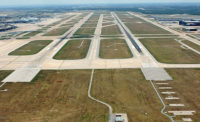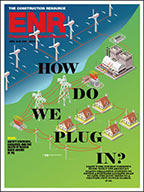Because the project is at an airport, keeping project information secure is critical. One of the team's projects includes renovations to the airport's communications facilities, which must be highly secure by federal mandate. If project information is lost or compromised, responsible parties could face federal prosecution.
Pistor says those documents reside on a separate folder on the server and all documents are encrypted and password-protected.
If an iPad that contains secure information is lost, the team is able to track where the device is and, if necessary, wipe it clean remotely.
A paperless project
The team's iPad strategy was enabled by a larger paperless project initiative. Early in the project, DFW and its team pushed for the project to go paperless, says Dwain Brown, TRIP implementation director and a program manager at Freese and Nichols. "DFW already has a forward-looking green policy in its operations, so this type of efficiency made sense," he says.
Designers complete electronic files, then reviewers mark them up electronically and return them to the design team. "It has significantly streamlined our quality assurance review process," Brown points out.
With designers and subcontractors coming on board, everyone can exchange electronic files. "Our guys can keep two sets of documents with them—one is the permit set and the other is the record drawings, so you can always compare them," Brown says.
As an added benefit, the need to create a cloud server that could sync to the team's iPads prompted the team to establish a single-source server of all drawings.
"We no longer had a fragmented system of PDFs from some sources, our printed record sets and others with a reprographics company, plus all of the versions among the subs," Bringardner says. "We all work from the same source, so it reduces the risk of working from old documents. He adds that "for everybody—whether it's code inspectors, designers or subs—when we open drawings we're all looking at the same set. That was an unforeseen but equally significant result of the system."
BARC also agreed to share across competitor boundaries. The team worked with the MBJ3 construction joint venture, which is renovating two other terminals, to add members to the system for the benefit of the overall program. The MBJ3 team includes Manhattan Construction Co., Thos. S. Byrne, James R. Thompson, and 3i Construction. Brown estimates that by going paperless across all projects under TRIP, the program could save between $8 million and $10 million.








